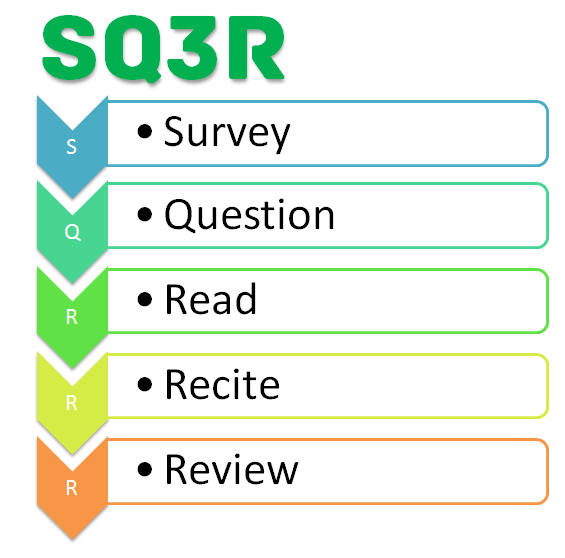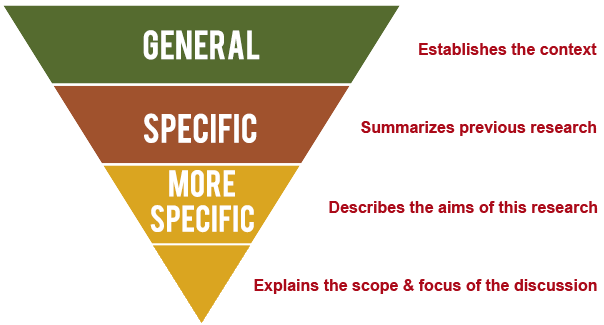How to Read an Academic Article

The Usual Method: SQ3R
SURVEY
Skim the text for a general idea of what it is about suitable information for your purpose.
QUESTION
Why are you reading this article? What do you want to get out of it? How will you use the information?
READ
Look for the main ideas. Begin with the abstract and introduction, then go to the conclusion, making note of the section headings along the way. Decide if anything is useful for your purpose.
RECITE (RECALL)
Note the main points of the article, as if you're trying to tell it to someone else. Make sure that you can answer the questions above.
REVIEW
Look back to see if the text has provided you with what you wanted
Robinson, Francis P. Effective Study. Harper, 1946.
Focusing on the Argument
(more useful for the humanities, some social sciences, and the profesional fields)
One of the keys to finding your way through the specialized and often dense texts produced by scholars is remembering that somewhere early in the text the writer needs to tell the reader how his or her study contributes something original to the scholarship on the subject. It may be a correction of some past misunderstanding; it may be the inclusion of some consideration or variable that previous researchers have missed; it may be applying a theory or concept in a new way or in a place it has not previously been used. Make it your first goal to find that claim. Once you know that claim, you will be better able to understand the author's choices, and better able to evaluate the effectiveness of the argument.
Another key is that academic language is subtle, understated. Scholars rarely exhort readers adamantly to reject the lousy scholarship of those who came before and see the brilliance of their fresh new positions. You therefore need to be very attentive to small rhetorical signs like "but" and "although."
While close reading for these subtle rhetorical roadmaps, use the following questions to guide you in locating the claim:
- What question does the author pose?
This typically is implied rather than stated explicitly, so you might be searching for something that is not literally in the text. - Thesis / Position / Argument / Claim
- What is the primary argument made by the author?
- Where do you first find the argument?
- What language indicates to you that this is the primary argument?
- Context
- Why is the argument significant?
- What other positions does the author indicate are debated regarding the topic?
- When was the article written? Where was it published? Who was the intended audience?
Again, you will need to use close reading skills to uncover the nuances of the argument and to evaluate its effectiveness in making its claims and engaging with other positions. For example, notice how the writer introduces evidence in support of his or her claim. Does the writer simply say, "Many literary scholars have argued unconvincingly that Hester Prynne's return to Salem in the end of The Scarlet Letter attests to Hawthorne's anti-feminist attitude toward women artists"? Or does the writer engage the theses of specific literary scholars who, no doubt, have their own nuanced readings? In some cases, the argument that gives attention to the complexity of a few other arguments (rather than generically referring to "many scholars" or "studies that show") can produce the more complex and subtle claims. Then again, sometimes writers must generalize in order to distinguish themselves more broadly from others. If they get too hung up on subtle points of differentiation between their arguments and those of others, the significance of their claims may get lost in the trees. Be aware of the relative effectiveness or ineffectiveness of either approach, depending upon the scope of the argument.
While continuing to close read for the subtle rhetorical ways in which the writer builds his or her case, use the following questions to help you sort out the building blocks of the writer's argument:
- Evidence
- What evidence does the author offer in support of the position put forth? (Identify all pieces of evidence you find.)
- What is the nature of each piece of supporting evidence? For example, is it based on empirical research, ethical consideration, common knowledge, anecdote?
- How convincing is the evidence? For example, does the research design adequately address the question posed (#1 above)? Are the ethical considerations adequately explored and assessed? Have you read or heard anything on this subject that confirms or challenges the evidence?
- Counter arguments
- What arguments made in opposition to the author's views were described?
- Were these arguments persuasively refuted?
- What evidence was used in the refutation?
- Effectiveness
- What were the strengths of the article?
- Was it difficult to read and understand? If so, why? If not, why not?
- Were you able to follow the moves of the article from thesis to evidence, for example?
- Did the structure of sentences and paragraphs and the overall organization guide you and help you follow the author's intent?
- Did all the material seem relevant to the points made?
"Negotiating Scholarly Texts." Writing and Communication Center, University of Washington Bothell. www.uwb.edu/wacc/teaching/resources/reading/neg-texts
A Structural Approach
| Function | Reading Strategies |
|---|---|
| Title provides information about the contents of the article. |
Read it first. Predict the main conclusions. |
| Abstract Provides a complete overview of what the research is about, what was done, how it was done, what was found, and what the results mean. |
Read to gain an understanding of the paper and the research findings. Ask yourself how you might use this information. |
| Introduction Provides a brief review of previous research, a rationale (reason) for the research, and an outline of the research aims. Knowledge about this structure will help you read it efficiently. |
Locate relevant information and develop a clearer picture of what the research is about and why it has been done. This diagram is an outline of the sequence of information in an introduction. |
| Methodology Describes the methods used in the research. |
Identify the specific research methods used to gather the findings. |
| Results Describes the findings. (Sometimes the results and discussion sections are combined.) |
Locate and note the main findings |
| Discussion Provides an interpretation of what the results mean in terms of the original research question or hypothesis, and in the field. |
Read the discussion section to understand what the results mean e.g. validity, limitations, consequences, implications. Ask yourself how you will use the information. |
| Conclusion (or general discussion section) A discussion of the meaning and implications of the research. It may also detail the implications of the research and make recommendations for changes to policy and practice directions or directions for further research. |
Read the conclusion for an understanding of the key issues resulting from the research. |
| References The literature on which the research was based. |
Scan the titles in the references to see if there are other research articles or publications you could use for further information. |
"Reading Academic Articles." Study and Learning Centre, RMIT University, emedia.rmit.edu.au/learninglab/sites/default/files/Reading_academic_articles_accessible_2015.pdf
Infographic

Rodriguez, Natalia. "How to Read Scientific Papers." Elsevier Connect, www.elsevier.com/connect/infographic-how-to-read-a-scientific-paper
Online Practice
For a good online practice article, check out this tutorial from the Hunter College Libraries at CUNY. The format is intuitive and outstanding.
This site presents a typical academic article, “Academic Achievement in First Generation College Students: The Role of Academic Self-Concept,” from the Journal of the Scholarship of Teaching and Learning. But it also contains a series of questions about the article, questions that address and reinforce students’ abilities to read in the manner discussed above.
Resources
Here are three articles that work well:
Pocketmod
Keep track of assignments, cheaply and easily. You can mod these to personalize them.
Cornell Notes
It's not a matter of choosing the best system for taking notes; it's a matter of choosing any system at all.
The Learning Toolbox at JMU
This one-stop shop provided by the College of Education at James Madison University might be pitched a bit low, but it addresses a number of student issues in stdying, notetaking, reading, etc.